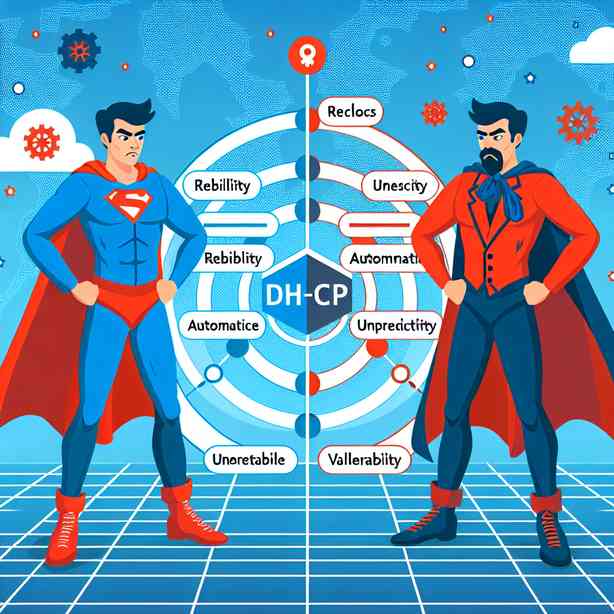
Dynamic Host Configuration Protocol (DHCP) is a critical networking protocol used to automate the process of assigning IP addresses and other network parameters to devices on a network. While DHCP is often viewed as a hero in simplifying network management and enhancing connectivity, it also harbors certain vulnerabilities that can make it akin to a villain in specific contexts. In this discussion, we will explore both the heroic traits and the villainous aspects of DHCP, shedding light on why it is essential yet potentially risky in modern networking environments.
To start with the heroic side, DHCP significantly streamlines the process of network configuration. Traditionally, network administrators would manually assign IP addresses to each device, which can be cumbersome, especially in larger networks. DHCP automates this process, enabling devices to dynamically obtain an IP address, subnet mask, and other essential network settings as they connect to the network. This automation not only reduces human error but also minimizes the time and resources required to manage IP assignments efficiently.
Moreover, DHCP enhances network scalability. In environments where devices frequently join and leave the network, such as corporate offices and educational institutions, DHCP allows for seamless integration of new devices. With the potential for hundreds or even thousands of devices to connect, manual IP address management quickly becomes infeasible. DHCP alleviates this burden, permitting the dynamic allocation of IP addresses from a defined pool, thus ensuring efficient use of available addresses.
Another noteworthy aspect of DHCP’s heroism is its ability to support mobility and flexibility in networks. In a world where remote work and telecommuting are increasingly common, devices frequently need to connect to different networks. DHCP simplifies this transition by allowing devices to automatically receive new network configurations as they connect to different environments. This feature is particularly beneficial for laptops and mobile devices, which may move between various networks throughout the day.
On the flip side, DHCP is not without its vulnerabilities, rendering it somewhat villainous in certain scenarios. One of the most significant risks associated with DHCP is its susceptibility to various types of attacks. For example, a malicious user can set up a rogue DHCP server on the network. When devices attempt to connect, they may inadvertently receive incorrect IP addresses and network settings from this unauthorized server. This can lead to man-in-the-middle attacks, where malicious actors intercept data, or denial-of-service situations, where legitimate devices are unable to connect to the network.
In addition to unauthorized DHCP servers, there are other security concerns related to DHCP. For instance, DHCP does not inherently include methods for authenticating clients or servers, making it difficult to ensure that only legitimate devices are receiving IP configurations. This lack of authentication opens the door for DHCP spoofing, where an attacker adopts the identity of a legitimate DHCP server to mislead clients.
Although it is possible to mitigate some of these risks through techniques such as DHCP snooping, which helps filter untrusted DHCP messages, these solutions often require additional complexity in network configuration and management. This added complexity can lead to misconfigurations that may inadvertently expose the network to problems.
Furthermore, the rapid pace of technology evolution can also pose challenges for DHCP. As networks become increasingly connected and more devices, including IoT devices, access them, the nature of DHCP assignments must adapt. Network administrators must keep in mind the pool exhaustion issue, where the available pool of IP addresses can be depleted in environments with a high turnover of devices. This situation emphasizes the need for meticulous planning and continuous monitoring of available addresses.
In conclusion, DHCP stands as both a hero and a villain within the realm of network management. The protocol undoubtedly facilitates dynamic address assignment and seamless network connectivity, championing efficiency and scalability in various networking scenarios. However, its vulnerabilities cannot be overlooked. The potential for unauthorized access and attacks underscores the importance of implementing security measures to safeguard the network while still benefiting from DHCP’s functionalities.
Ultimately, understanding both the strengths and weaknesses of DHCP is paramount for network administrators seeking to deploy it effectively. Security measures, such as network segmentation, DHCP snooping, and careful monitoring, can help mitigate the risks associated with this essential protocol. Striking a balance between enjoying the advantages of DHCP while warding off its potential dangers is vital in today’s networking landscape. By doing so, organizations can harness the full power of DHCP while maintaining robust security and operational efficiency.
As networks continue to evolve, so too will the strategies utilized to manage them. In navigating the fine line between the heroic and villainous traits of DHCP, network professionals play an invaluable role in ensuring that networks remain resilient, secure, and efficient. With a comprehensive understanding of these dynamics, they can fully leverage DHCP’s capabilities while guarding against the threats it poses. Thus, DHCP remains an indispensable tool in the arsenal of network management, combining potential risks with profound advantages in a way that must be judiciously navigated for optimal outcomes.


